Your Guide to Construction, Renovation, and Zoning Laws in Ohio
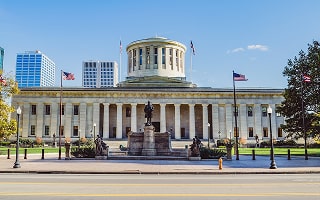
Investing in Ohio property can be the road to wealth building. Construction, renovation, and zoning laws impact property to the degree that you may want to learn all you can before investing. Ohio has 4,242,400 residential properties. That figure includes single-family homes, multi-family homes, and other types of dwellings. Although there is no definitive figure, Ohio has a substantial number of commercial properties, particularly manufacturing plants. Ohio has a total of 5.22 million housing units.
Property-related laws fall into two general categories: state-level and local (town/city/county/municipality). Each state divides property law responsibilities between these two entities; some laws fall under the jurisdiction of the state, while others fall under the jurisdiction of local government. Under each main category, there are many different rules and regulations to review.
State Level (Regulations & Codes)

Ohio's building and renovation laws at the state level include various provisions, such as contract requirements, payment schedules, and statutes of limitations (the time frame within which someone must bring a lawsuit against a contractor related to construction defects). Ohio also sets the standards for building codes adopted by each municipality or county, which are then modified to suit the local area's specific needs.
The Ohio Board of Building Standards (BBS) is the primary state entity responsible for developing, adopting, and administering the Ohio Building Code. However, the actual enforcement of these codes is often delegated to local building departments, who are certified by the BBS. The BBS is a section of the Ohio Department of Commerce. Local building departments (within city or county governments) are responsible for reviewing construction plans, conducting inspections, and ensuring that buildings are constructed in compliance with the Ohio Building Code.
The Ohio Building Code Compliance Division, also within the Ohio Department of Commerce, provides oversight and support to local building departments and may handle enforcement for specific industrial units.
Ohio uses the 2024 Ohio Building Code, which is based on the 2021 International Building Code with amendments specific to the state of Ohio. Other codes used in Ohio include:
-
2019 Residential Code of Ohio Amendments
-
2024 Ohio Building, Mechanical & Plumbing
-
2024 Ohio Plumbing Code
-
2024 Ohio Existing Building Code
-
2019 Residential Code of Ohio
-
2017 Ohio Energy Code: Energy Efficiency Provisions of the Ohio Building Code
-
2017 Ohio Fire Code with January 2019 Errata
-
2015 International Property Maintenance Code
-
2024 Ohio Mechanical Code
-
2024 Ohio Building Code
-
2015 International Fuel Gas Code
Construction
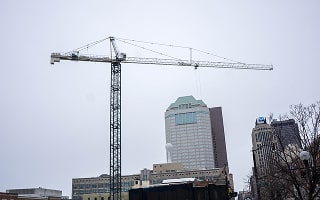
Ohio construction laws include various regulations, including building codes, payment requirements, and contracting practices. A few examples are the Ohio Building Code, Fairness in Contracting Act, and wage payment laws. The BBS is responsible for creating and maintaining building codes. These building code laws govern the construction, alteration, and equipment of buildings and structures.
The Fairness in Contracting Act, as found in Ohio Revised Code § 4113.62(B), addresses contract provisions related to final waivers of claims. Specifically, it declares any contract clause requiring a contractor to sign a final waiver of claims to receive final payment if the contractor has asserted a claim or requested a price adjustment, to be void and against public policy.
Ohio Revised Code §4113.15 mandates how often employers must pay their employees. It requires employers to pay employees for wages earned during the first half of the preceding month by the first day of the next month, and for wages earned during the second half of the prior month by the 15th day of the following month.
Ohio Revised Code Chapter 3791 outlines regulations for specific types of buildings and structures, including opera houses, halls, theaters, schools, and hospitals. Section 3781.02 provides exceptions to certain building requirements.
Some of the key construction laws in Ohio include:
-
Contracts: Ohio law requires construction contracts to be in writing and include specific details, such as a description of the goods and services, a cost estimate, start and end dates, and a copy of the contractor's insurance. Down payments are limited to 10% of the total cost, unless custom or specialty orders are involved.
-
Payments: Ohio law mandates semimonthly wage payments for construction employees. Contractors must pay employees for wages earned during the first half of the month by the 15th and for the second half by the end of the month.
-
Statutes of Limitations: Ohio law sets specific time limits for bringing legal actions related to construction defects. Actions for personal injury, property damage, or wrongful death due to defects must be filed within 10 years of substantial completion of the project. There are also other timeframes, such as 6 years from various dates related to the work.
-
Noise Regulations: Construction start times can vary by city in Ohio, with most allowing work from 7 a.m. to 9 p.m. Some cities have restrictions on weekend and holiday work, while others permit extensions with approval.
-
Consumer Sales Practices: The Ohio Consumer Sales Practices Act (OCSPA) applies to consumer transactions and prohibits unfair or deceptive practices.
Commercial Structures

Ohio's commercial construction laws involve contractor licensing requirements, building codes, and regulations regarding wages and worker safety. The 2024 Ohio Building Code governs construction of commercial buildings (4-family units or greater).
Some of the details of commercial construction laws in Ohio include:
- Licensing: All commercial contractors operating in Ohio are required to hold a valid license. The Ohio Construction Industry Licensing Board (OCILB) issues licenses for various commercial construction trades like HVAC, electrical, plumbing, hydronics, and refrigeration.
- Building Codes: Commercial projects must adhere to the 2024 Ohio Building Code with the latest amendments.
- Wage Payment: Employers are generally required to pay employees at least semi-monthly, with specific stipulations on the timing of payments.
- Worker Safety: Ohio has numerous laws in place to ensure worker safety, including provisions for access to medical reports and potential penalties for violations.
- Contractor Responsibilities: Construction contracts may include provisions for estimated costs, completion dates, and cancellation rights.
- Indemnification: Ohio law also addresses indemnity provisions in public works design contracts, potentially covering damages, losses, attorney fees, and other costs.
- Prompt Payment Laws: Ohio has laws regarding prompt payment in construction contracts, ensuring timely payments to contractors and subcontractors.
Commercial construction in Ohio is subject to a comprehensive set of laws designed to ensure safety, fair labor practices, and compliance with building standards.
Residential Structures

Ohio residential construction laws require written contracts for home improvement projects, which should include details such as a project description, estimated cost, and a cancellation clause. Additionally, contractors may be required to hold licenses for specific types of work, and obtaining a building permit is necessary before construction commences. Occupancy is also restricted until the building department issues an official approval, like a certificate of occupancy.
Some highlights of Ohio residential building law include:
- Written Contracts: The Ohio Home Solicitation Sales Act (HSSA) requires contractors to provide homeowners with a written contract for residential construction projects. This contract must include: a description of the goods and services, a total cost estimate, a start and finish date, and a right to cancel within three business days. The contract must also include a copy of the contractor's general liability insurance certificate.
- Building Permits: Most home renovations require a building permit. Construction or work requiring approval is subject to inspection. It's the owner's responsibility to notify the building department when work is ready for inspection. A certificate of occupancy or completion is needed before a building or structure can be used or occupied.
- Contractor Licensing: For larger projects (over $1,000), contractors may need an Ohio contractor license. The Ohio Construction Industry Licensing Board (OCILB) issues licenses for electricians, HVAC contractors, hydronic technicians, plumbers, and refrigeration installers.
- Building Codes: Residential projects must comply with Ohio Building Code. These codes are based on the International Code Council (ICC) standards. They include codes for residential construction in high-wind regions, frost-protected shallow foundations, and accessible and usable buildings.
Safety Standards

Ohio's construction safety standards are primarily enforced through the Ohio Bureau of Workers' Compensation (BWC) and the Ohio Revised Code, as well as federal OSHA regulations. Employers in Ohio must provide a safe working environment, which includes complying with specific OSHA standards and the "General Duty Clause" of the OSH Act. This clause requires employers to protect employees from recognized hazards in the workplace.
The Ohio Revised Code doesn't have a specific section dedicated solely to "construction safety". Instead, safety regulations are spread throughout various chapters and sections related to labor, public works, and particular industries.
Some examples of safety standards in Ohio are:
- Chapter 4101: Labor and Industry: This chapter includes various aspects of labor law, including workplace safety. However, specific construction safety regulations are often found in the Ohio Administrative Code (OAC) rather than the Revised Code.
- Chapter 4121: Industrial Commission and Bureau of Workers' Compensation: This chapter deals with workers' compensation and the administration of workplace safety programs. It includes provisions for safety inspections, employer responsibilities, and penalties for violations.
- Chapter 153: Public Works: This chapter governs contracts for public works projects, which often involve construction and other related activities. It includes provisions related to bidding, bonding, and prevailing wage requirements, which indirectly impact construction safety.
- Ohio Administrative Code (OAC): The Ohio Administrative Code, particularly rules developed by the Bureau of Workers' Compensation (BWC), contains detailed safety standards for various industries, including construction. These standards are based on OSHA (Occupational Safety and Health Administration) regulations.
Some specific areas of focus within safety laws include:
- Fall Protection: Ohio law and OAC rules emphasize the importance of fall protection requirements for construction workers, particularly in high-rise buildings.
- Scaffolding and Ladders: Specific regulations govern the safe use of scaffolding and ladders in construction, including proper setup, inspection, and usage.
- Excavation and Trenching: Ohio has detailed rules for safe excavation and trenching practices to prevent collapses and cave-ins.
- Personal Protective Equipment (PPE): Ohio law and OAC rules require the use of appropriate PPE, such as hard hats, safety glasses, and gloves.
- Hazard Communication: Construction sites must comply with regulations regarding the proper labeling, handling, and storage of hazardous materials.
- Electrical Safety: Ohio laws also include regulations that cover safe electrical practices, including grounding, guarding, and proper wiring.
The Ohio BWC oversees workplace safety and health for most private employers in the state, ensuring compliance with Ohio laws and regulations. Ohio employers must comply with all applicable OSHA standards, which cover a wide range of construction-related hazards, including fall protection, electrical safety, and hazard communication. The OSH Act's General Duty Clause requires employers to identify and address any recognized hazards in the workplace that could cause death or serious physical harm to employees.
The Ohio Bureau of Workers' Compensation also focuses on specific safety initiatives within the construction industry, such as those related to communication towers, highway work zones, and preventing back overs.
Building Codes

Ohio building codes are based on the 2021 International Building Code (IBC). The codes used by Ohio and amended by the state include:
- 2024 Ohio Building Code
- 2019 Residential Code of Ohio
- 2024 Ohio Existing Building Code
- 2017 Ohio Energy Code: Energy Efficiency Provisions of the Ohio Building Code
- 2017 Ohio Fire Code with January 2019 Errata
- 2015 International Property Maintenance Code
- 2024 Ohio Mechanical Code
- 2015 International Fuel Gas Code
- 2024 Ohio Plumbing Code
Asbestos Laws

The Ohio Environmental Protection Agency (Ohio EPA)governs asbestos construction laws within the state. These laws are consistent with the federal National Emission Standards for Hazardous Air Pollutants (NESHAP). These regulations require specific steps to be taken during demolition and renovation projects involving buildings that may contain asbestos.
Some of the highlights of Ohio asbestos laws regarding construction include:
- Asbestos Hazard Evaluation: A certified asbestos hazard evaluation specialist (AHES) must inspect the building to determine the presence or absence of asbestos-containing materials (ACM) before any demolition or renovation begins.
- Notification Requirements: The building owner or manager must notify the Ohio EPA before demolition or renovation projects that may disturb ACM. This notification must include the abatement dates.
- Abatement Procedures: If asbestos is found, it must be abated by a certified asbestos abatement contractor following specific procedures to minimize the release of asbestos fibers.
- Emission Control: Ohio's regulations include specific requirements to control asbestos emissions during demolition and renovation, such as preventing visible emissions into the outside air.
- Waste Disposal: Asbestos-containing waste must be handled and disposed of in accordance with regulations to prevent environmental contamination.
- Residential Buildings: While NESHAP regulations generally apply to all buildings, residential buildings with four or fewer dwelling units may have different requirements.
Ohio's asbestos laws are designed to protect workers and the public from asbestos exposure during construction activities by ensuring proper identification, handling, and disposal of asbestos-containing materials.
Contractor Licensing Laws
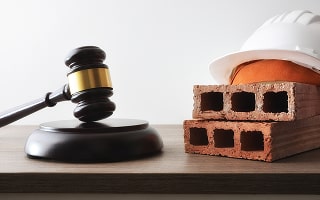
In Ohio, contractors working on large-scale construction projects (valued at over $1,000) may need to obtain a state-level license from the Ohio Construction Industry Licensing Board (OCILB). This includes those specializing in electrical, HVAC, hydronics, plumbing, and refrigeration. Additionally, residential contractors need to register with the Ohio Construction Compliance Board (OCCB).
Some key aspects of Ohio contractor licensing laws are:
- State Licensing: The OCILB regulates licenses for electricians, HVAC contractors, hydronics technicians, plumbers, and refrigeration installers.
- Residential Registration: Residential contractors need to register with the OCCB.
- Local Requirements: Some municipalities, such as Cincinnati and Cleveland, require local contractor registration, even if the contractor holds an OCILB license.
- Registration with the Department of Buildings & Inspections: General contractors in certain areas may be required to maintain current contractor registration with the Department of Buildings & Inspections.
- Licensing Exams: Applicants may need to pass both a business and a law exam, as well as a trade exam specific to their area of expertise.
- Violations: Unlicensed contracting can result in misdemeanor offenses, and obtaining the proper permits is essential for all construction projects in Ohio.
You can verify a contractor's commercial license through the OCILB website.
Insurance & Bonds
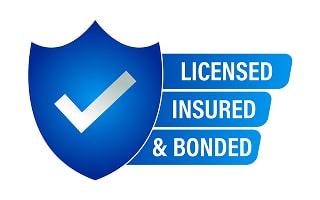
In Ohio, contractors typically need both insurance and surety bonds to operate legally, though specific requirements can vary by city and county. Generally, contractors require general liability insurance with a minimum coverage of at least $500,000. Additionally, many municipalities require a surety bond, such as the $25,000 bond required by the City of Columbus. Contractors should verify requirements with their local building department before starting any work.
Contractors require general liability insurance, which protects against property damage and bodily injury caused by the contractor's work. Depending on the specific trade or municipality, contractors may also need additional insurance, such as workers' compensation and automobile insurance, if they use vehicles in the course of their job.
Many Ohio cities and counties require contractors to obtain a surety bond as part of their licensing process. These bonds provide a financial guarantee that the contractor will comply with all contract terms and local regulations. The bond amount can vary by location. For example, Columbus requires a $25,000 bond. Contractor license bonds are typically classified as either "performance" bonds, which guarantee the contractor's completion of work as agreed upon, or "payment" bonds, which guarantee payment to subcontractors and suppliers.
Public Works Contracts/Public Bidding

In Ohio, public works projects are generally government-sponsored construction projects that improve public infrastructure. These projects are often funded through a combination of state and local funding and are managed by various government entities. The Ohio Public Works Commission (OPWC) plays a significant role in providing financial assistance for these projects. Some examples of public works projects include:
- Road and bridge construction and maintenance.
- Water and wastewater system upgrades.
- Stormwater management projects.
- Public building construction and renovation (e.g., schools, libraries, government buildings).
A combination of statutes, administrative rules, and contractual agreements governs Ohio's public works projects. Public works projects are typically managed by government agencies, such as the Ohio Department of Transportation (ODOT) or local public works departments. These agencies are responsible for planning, designing, and overseeing the construction of the projects. Local governments often partner with the OPWC and other entities to secure funding and receive project support.
In Ohio, public construction contracts require the principal contractor to have a payment bond in place. This bond protects subcontractors, suppliers, and laborers by ensuring they will be paid for their work and materials.
Unlike private construction projects, liens against public property are generally prohibited in Ohio.
Public works projects often involve public input and engagement to ensure they meet the community's needs. Public works projects can have a significant impact on the local economy by creating jobs and improving infrastructure, thereby attracting further investment.
Renovations

Ohio laws regarding construction renovations primarily focus on construction defect claims, licensing requirements, and fair contracting practices. Specifically, claims for defective improvements must be filed within ten years of the substantial completion date of the improvement. Commercial construction contractors may be required to hold state-issued licenses. Additionally, Ohio has laws to protect contractors from unfair contract terms related to final payments.
Some of the highlights of these laws are:
- Statute of Limitations: Ohio Revised Code § 2305.131 sets a ten-year statute of limitations for claims related to construction defects in improvements to real property. This means that lawsuits for damages arising from defective or unsafe conditions must be filed within ten years from the date the improvement is substantially completed.
- Commercial Renovations: For commercial projects involving HVAC, electrical, plumbing, hydronics, or refrigeration, contractors generally need a state-issued license from the Ohio Construction Industry Licensing Board (OCILB).
- Home Construction Services: Ohio law now defines "home construction service" to include renovations and improvements to existing residential buildings, as well as new construction of residential buildings.
- Minimum Quantifiable Standards: The Ohio Home Builders Association is designated to adopt standards defining "workmanlike manner" for all home construction service suppliers, per the Ohio Revised Code § 4722.01(G).
Environmental Laws

Ohio's environmental laws for construction projects focus on protecting natural resources and ensuring public safety by regulating areas such as soil contamination, air and water quality, and waste management. These regulations guide construction activities to minimize environmental harm and prevent pollution.
Some of the highlights of Ohio's environmental construction laws include:
- Construction and Demolition (C&D) Debris Management: Ohio has regulations governing the handling and disposal of C&D debris, which includes materials such as concrete, asphalt, wood, metal, and gypsum wallboard. US EPA fact sheets guide the management of this type of waste, which can include land clearing debris.
- Public Improvements: For public construction projects, Ohio law requires a "notice of commencement" to be readily available to the public, outlining the project details.
- Environmental Permits: Construction projects may require various environmental permits, depending on the nature and scale of the work. These permits ensure compliance with air and water quality standards, and proper management of any potential pollutants.
- Soil and Water Protection: Construction activities can impact soil and water resources. Ohio regulations are designed to prevent soil erosion, runoff, and contamination of water bodies.
- Air Quality: Construction activities can generate dust and other air pollutants. Ohio laws may require measures to control dust emissions and maintain air quality during construction.
- Contract Requirements: Construction contracts in Ohio must be in writing and include specific information, such as a detailed description of the work, cost, timelines, and insurance details. Additionally, they must comply with the Fairness in Contracting Act regarding final payments and claims.
Solar Regulations

Ohio's solar regulations are a mix of state laws and local ordinances, with some areas seeing increased restrictions on solar projects while others are expanding solar energy through more flexible laws.
Some of the highlights of Ohio's solar regulations include:
-
Building Permits: All solar installations, whether rooftop or ground-mounted, require building permits before work can begin.
-
Ohio Power Sitting Board (OPSB): The OPSB regulates solar facilities larger than 50 megawatts, including mandatory setbacks (50 feet from property lines, 300 feet from non-participating residences) and noise level restrictions.
-
Local Government Rules: While the state law allows local governments to influence large solar projects, it also limits their ability to restrict smaller, grid-connected projects.
-
Homeowners Associations (HOAs): HOAs cannot unreasonably restrict homeowners' ability to install solar panels.
-
Senate Bill 61 (2022): This bill solidified solar access laws, preventing HOAs from outright banning solar installations.
-
House Bill 15 (2025): This bill includes provisions for reducing the tangible personal property tax on new energy generation (including energy storage systems) and expands the potential for behind-the-meter generation.
-
Ohio's Renewable Portfolio Standard: This standard sets goals for renewable energy production and includes incentives like Solar Renewable Energy Credits (SRECs).
Solar Renewable Energy Credits are available to incentivize solar installations. Homeowners may be eligible for various state and federal tax credits and rebates for solar installations.
Some counties have banned or restricted solar and wind projects, citing concerns about their impact on the community.
Gas/Oil

Ohio regulations for oil and gas heating systems are about safety and efficiency, encompassing both fuel storage and the installation of appliances. Some rules address clearances around heating equipment, proper venting, and safe fuel handling practices. Specific rules exist for natural gas and fuel oil, including requirements for permits, storage capacity, and adherence to national standards like NFPA 70 and 31.
Ohio regulations specify minimum distances between heating devices (both solid/liquid fuel, as well as gas) and combustible materials, such as walls and ceilings. Proper venting of heating appliances is crucial to prevent carbon monoxide buildup. Stovepipes and exhaust vents need adequate clearance from walls and ceilings, and vented, fire-resistant collars are required where vents pass through combustible materials. Fuel oil and gas storage systems have specific requirements. Permits are required for fuel oil storage exceeding 60 gallons, and such storage must comply with relevant national standards, including NFPA 31 for oil and the International Fire Code for both oil and gas.
In the event of flame failure, temperature, or pressure faults, heating systems must include automatic controls that shut off the fuel supply to prevent catastrophe. Ohio law sets a minimum heating value for natural gas (900 BTU/cubic foot) and regulates its distribution.
When performing "hot work" (such as welding, cutting, etc.) near potential fire hazards, precautions must be taken to prevent the ignition of combustibles. This includes maintaining proper shielding and ensuring good housekeeping.
The State Fire Marshal has the authority to enforce these regulations and may issue rules for the safe use of unvented heaters in certain building types.
Electricity

Ohio law requires licensed electricians for electrical work during construction and renovations. General contractors may also require specific licenses for electrical work, depending on the project's scope and whether it is commercial or residential. Additionally, Ohio has regulations regarding energy conservation measures, fuel oil storage, and fire code compliance for electrical work, particularly with oil-fired appliances and storage tanks.
Handypeople generally do not need a license unless they are performing electrical, HVAC, plumbing, or refrigeration work. For commercial construction projects involving electrical work, a state-issued license from the OCILB is necessary.
Ohio has laws and regulations addressing energy conservation measures in buildings, including requirements for insulation and energy-efficient systems. Ohio contractors must comply with Ohio's Fire Code (Ohio Administrative Code 1301:7-7-06), which includes regulations for electrical work, particularly related to oil-fired appliances and fuel oil storage, requiring compliance with standards like NFPA 70 (National Electrical Code) and NFPA 31 (Standard for the Installation of Oil-Burning Equipment).
Government Housing Programs

Ohio has government-funded programs to help conserve and expand affordable housing while addressing homelessness and providing short-term emergency assistance for low-income residents. The Office of Housing Support offers financial and technical assistance to local governments and nonprofit organizations for projects that benefit low- and moderate-income citizens.
The "Ohio Office of Housing Support" isn't a specific, standalone office. Instead, it refers to the various housing-related programs and resources provided by the Ohio Housing Finance Agency (OHFA) and other state and local agencies, including those under the umbrella of the U.S. Department of Housing and Urban Development (HUD). These resources are to support Ohioans in finding and maintaining safe, affordable housing.
Some of the programs available in Ohio consist of:
- Homeownership Programs: The OHFA offers various programs for first-time homebuyers and those purchasing in designated target areas.
- Rental Assistance: OHFA administers programs such as the Ohio 811 Program, which provides rental subsidies and supportive services to low-income individuals with disabilities, and the Emergency Housing Assistance Program.
- Housing Locator: OhioHousingLocator.org is a resource for finding affordable and accessible rental housing throughout the state.
- Emergency Housing Vouchers: HUD provides Emergency Housing Vouchers (EHVs) to Public Housing Agencies (PHAs) to assist individuals and families experiencing homelessness or at risk of homelessness.
- Section 8 Housing Choice Vouchers: HUD also supports the Housing Choice Voucher Program (Section 8), which helps low-income families afford housing.
- Continuums of Care (CoCs): CoCs are regional or local planning bodies that coordinate housing and services for individuals experiencing homelessness.
- Permanent Supportive Housing (PSH): PSH offers long-term housing and comprehensive supportive services to individuals with disabilities.
- 2-1-1: Call 2-1-1 or visit 211.org to find information about local resources, including housing assistance.
- Ohio Department of Medicaid: The Ohio Department of Medicaid also provides information and resources related to housing, particularly for individuals receiving Medicaid benefits.
- Franklin County, Ohio: Franklin County offers resources, including Ohio Works First (OWF), a cash assistance program for families experiencing financial hardship.
Property Tax Credits and Incentives

Ohio offers several property tax exemptions and incentives to help property owners alleviate their property tax burden and make homeownership more affordable. Each program has specific requirements, and the homeowner must apply through the local county auditor's office. Some available property tax credits and incentives are:
- Homestead Exemption (reduces the taxable value by $26,200-$52,300)
- Owner Occupancy Credit (2.5% reduction in property taxes)
- Damaged Property Reductions
The Homestead Exemption is available to:
- Homeowners over the age of 65, with certain income requirements.
- Permanently and totally disabled homeowners.
- Military veterans with a 100% disability rating.
- Spouses of first responders killed in the line of duty.
The City of Columbus offers a Housing Abatement program that provides tax exemptions and abatements to encourage investment in specific neighborhoods, particularly those designated as "Ready for Revitalization" or "Ready for Opportunity." The abatements apply to the increased value of the property due to improvements, while the property owner continues to pay taxes on the original value.
Local Level (Permits and Regulations)
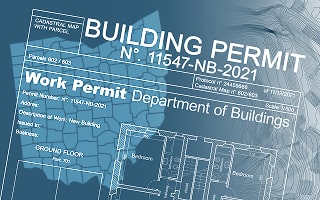
Ohio building codes are enforced at the local level through the issuance of building permits and regular inspections. Local government officials also develop zoning laws and determine how land will be used in specific areas.
The state offers building codes that provide minimum allowable standards, and then cities and counties can strengthen them if they wish. The state residential building code applies to one, two, and three-family dwellings, while the Ohio Building Code covers commercial and industrial buildings. Local governments can adopt additional regulations that are not in conflict with state codes.
Anyone who violates local building codes and practices may incur fines, receive stop-work orders, or face other penalties, including orders to correct violations and rebuild.
Building-Friendly Areas of Ohio

Some areas are easier and friendlier for building. For example, Columbiana County has more lenient building regulations compared to many other regions of the state, particularly regarding tiny homes and accessory buildings. Specifically, they permit permanent dwellings with a minimum floor area of 650 square feet and have fewer restrictions on accessory buildings. Other cities in Ohio are undergoing a rezoning process, which may make it easier to build new homes and commercial structures. Their goal is to address housing shortages and promote a broader range of housing options.
Where to Obtain Ohio Building Permits

Most construction projects and renovations require a permit before beginning. To obtain a building permit in Ohio, you must apply through your local building department, which may be located at the city, county, or town level. The specific process and requirements may vary based on the location and nature of the project, but the general process is as follows:
- Identify your local building department.
- Contact the department through its website, in person, or by phone to inquire about permits.
- Learn about the specific requirements and necessary documents, fees, and inspections.
- Complete and submit your application, along with the required documentation and payment for the fees.
- Once you obtain your permit, schedule your inspections.
- Obtain a Certificate of Occupancy once the work is complete to use the structure.
Some links to other building departments in Ohio include:
- City of Cleveland Department of Building and Housing
- City of Salem Building Department
- Columbus Building Department
- Franklin County Building Permits
- Lima Building Department
- Muskingum County Building Department
- Richland County Building Department
- Washington County Building Department
During the permitting process, the building inspector must inspect the work being performed. They may do this before, during, and after the project to ensure the work complies with all local building codes, thereby ensuring the safety of people. Depending on the city or county's rules, you may schedule your inspections through the online portal, by phone, or by email.
Zoning Laws
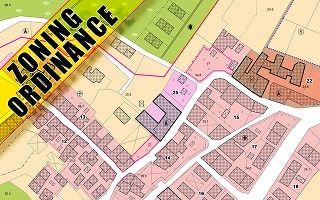
Ohio zoning laws are primarily enacted and enforced at the local level by cities, townships, and counties, rather than being a statewide mandate. These local governments have the authority to regulate land use, building types, and development through zoning regulations. Zoning ordinances dictate the types of structures and activities permitted in specific geographic areas, promoting orderly development and preventing conflicts between incompatible land uses. Zoning regulations also cover aspects like building placement, density, and setbacks.
Zoning codes are specific to each municipality and are outlined in their zoning maps and ordinances. Each zone has specific rules about what can be built, how large it can be, and how it must be situated on the property (setbacks, density). Zoning helps to create distinct communities and ensure that land uses are compatible. They can be used to encourage specific types of development, such as affordable housing or economic growth. Zoning can also protect natural resources and preserve historic areas.
Some of the zoning designations used for land throughout Ohio include:
-
Residential: This includes areas for single-family homes, multi-family dwellings, and other residential uses.
-
Commercial: This category encompasses a wide range of business types, including neighborhood shops, regional shopping centers, and office spaces. Some subcategories include neighborhood commercial, office commercial, mixed commercial-residential, storefront commercial, regional commercial, and downtown commercial.
-
Industrial: This area is designated for manufacturing, warehousing, and other industrial activities. Subcategories include light industrial and heavy industrial.
Other Zoning Designations:
-
Parks and Open Space: Areas designated for recreational and conservation purposes.
-
Institutional: Includes schools, hospitals, and other public or private institutions.
-
Agricultural: Protecting agricultural land and farming activities.
-
Historic Preservation: Designating areas for the preservation of historical buildings and sites.
Related Links and Enforcement Offices

When it comes to Ohio construction, renovation, building, and housing regulations, many government departments and agencies standardize, regulate, and enforce building rules. There is some overlap with their duties, but most in Ohio are at the local level. State agencies tend to set broad minimum standards, and then cities, towns, and counties customize and adopt them from there.
The links below provide detailed information on the state's construction, zoning, renovating, and housing rules.
Other Helpful Links
- Ohio Board of Building Standards (BBS)
- Ohio Department of Commerce
- Fairness in Contracting Act
- Ohio Revised Code §4113.15
- Ohio Consumer Sales Practices Act (OCSPA)
- Ohio Home Solicitation Sales Act (HSSA)
- Ohio Bureau of Workers' Compensation (BWC)
- OSHA regulations
- Ohio Environmental Protection Agency (Ohio EPA)
- National Emission Standards for Hazardous Air Pollutants (NESHAP)
- Ohio Construction Compliance Board (OCCB)
- Ohio Public Works Commission (OPWC)
- Ohio Department of Transportation (ODOT)
- Ohio Housing Finance Agency (OHFA)